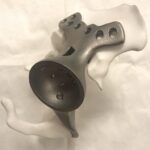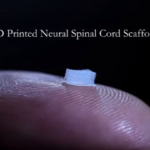
 3D printed implants have been used in all kinds of surgeries, from dental, facial, and spinal to the chest, ears, and hips. But the thing about implants, whether they’re 3D printed or not, is that typically, when they’re brought into use, doctors are treating a disease or other medical issue that’s already progressed too far to fix any other way. An example is the story of Amit Bhanot, who was diagnosed in 2000 with a severe form of arthritis called ankylosing spondylitis that had caused his right hip to fuse. After having both of his hips replaced about ten years ago, doctors provided him with a new, 3D printed titanium implant when he began to experience pain again this year.
3D printed implants have been used in all kinds of surgeries, from dental, facial, and spinal to the chest, ears, and hips. But the thing about implants, whether they’re 3D printed or not, is that typically, when they’re brought into use, doctors are treating a disease or other medical issue that’s already progressed too far to fix any other way. An example is the story of Amit Bhanot, who was diagnosed in 2000 with a severe form of arthritis called ankylosing spondylitis that had caused his right hip to fuse. After having both of his hips replaced about ten years ago, doctors provided him with a new, 3D printed titanium implant when he began to experience pain again this year.
Think how much better Bhanot’s life could have been if he had received an implant earlier on. According to Dr. Jonathan Jeffers with the Department of Mechanical Engineering at Imperial College London, bone and joint disorders are currently one of the largest expenditures across the National Health Service (NHS) in the UK, because the “human musculoskeletal system has not caught up with improvements in life expectancy over the last 150 years or so.”
“The current generation of orthopaedic implants are brilliant, but they tend to treat the end-stage disease, and are very invasive, because they involve chopping out the entire joint. What surgeons need is something that can treat younger patients, to try to prevent the disease progressing,” Dr. Jeffers explained.
The type of implant that can fix early problems in joints and bones before they’re too serious, referred to as an early intervention implant, is just one of the technologies that will be developed in a new research and development center at the educational institution.
Thanks to £1.7 million in funding from the Engineering and Physical Sciences Research Council (EPSRC), the Medical Device Prototype and Manufacture Unit is currently being established at Imperial College London.
The summary on the grant application form reads, “Our vision is for lifelong musculoskeletal health. We consider the only way to achieve this is to identify musculoskeletal problems early in life, then make small interventions to correct them before they become chronic. This preventative approach needs new technology which we will create using the equipment in the Medical Device Prototype & Manufacture Unit.
“Our research will be conducted in an environment that will strongly encourage translation. The Prototype & Manufacture Unit will be set up with all the regulatory approval and quality control to enable us to manufacture devices from first off prototypes through to small batch production parts for early clinical safety studies. This combination of cutting edge AM and imaging equipment in an environment with strong emphasis on translation would enable us to break new ground in all our research themes and also bridge the gap between exciting laboratory testing and clinical practice.”

Dr. Jeffers is the principal investigator on the project, and the grant also lists Renishaw as a project partner. The new unit will use advanced imaging techniques and 3D printing to manufacture parts with nanoscale features, so they can study their interactions with the human body.
“Engineers have a tremendous responsibility to apply science in a way that improves the health and wealth of the nation. It is imperative that we take technology out of the laboratory and put it in the surgeon’s hands,” said Dr. Jeffers. “This exciting award gives us the tools and now we’ll finish the job.”
In addition to 3D printing early intervention implants with material that’s tailor-made to strengthen the surrounding bone, the cross-departmental team of researchers from the departments of Surgery and Cancer, Mechanical Engineering, Materials, and Bioengineering hope to make repair patches for capsules, tendons, and ligaments that can adhere to soft tissue using a Velcro-like surface.
They’re also planning to make smart instruments and implants that are able to measure joint health using biomarkers in synovial fluid, as well as new biomaterials, like nanoneedles, that are able to get past bacteria cell membranes and behave like an an anti-infection coating for 3D printed implants.
According to Dr. Jeffers, the team will use a 3D printer from Renishaw, which has experience with smart implants, that can manufacture objects out of titanium, along with a smaller, two-photon lithography system, to make parts from the nanoscale to the millimeter scale.
Dr. Jeffers explained, “These technologies will enable material to be manufactured with the same mechanical properties as bone, which means the bone will accept the implant better than they currently do.”
Then, the team will use a 3D digital microscope and a micro-CT scanner to complete a detailed study of the 3D printed parts. The project is set to begin this September.
Discuss this and other 3D printing topics at 3DPrintBoard.com or share your thoughts in the comments below.
If you're looking to request photorealistic CGI in the USA, our service offers an easy and efficient way to get stunning, lifelike renderings for your architectural and real estate projects. Through our platform, you can quickly request high-quality CGI images that accurately capture the essence of your designs. Whether it's for a residential or commercial property, our experts specialize in creating realistic 3D renderings that highlight every detail, bringing your vision to life with exceptional clarity and precision.
Through our website, requesting photorealistic CGI becomes a seamless experience. With our help, you can get highly detailed 3D visualizations that look just like photographs, providing a realistic representation of your project before it's even built. Our team ensures that every element, from textures to lighting, is meticulously rendered, giving you an impressive, lifelike result that will leave a lasting impact on your clients and stakeholders.






Leave a Reply
You must be logged in to post a comment.